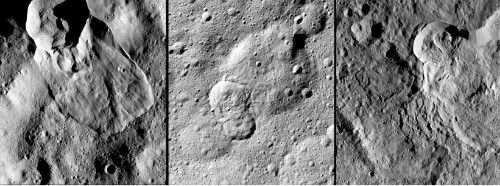Ceres: Exploration
Ceres is a good example of how challenging it can be to categorize bodies in our solar system. When Giuseppe Piazzi first spotted it in 1801, he assumed Ceres was the "missing" planet between Mars and Jupiter. Within a few years, Pallas, Juno, and Vesta were also discovered in the region, and they too were called planets. Starting in the 1840s, astronomers discussed reclassifying the increasing number of bodies in this area, since they didn't quite fit the definition of a planet.
By 1860 a total of 62 bodies had been discovered in the space between Mars and Jupiter. And by 1863 astronomers accepted the classification of these objects as asteroids and called the area the asteroid belt. That's the way it stayed for over 140 years.
Then in 2006, astronomers designated Ceres a dwarf planet, since it matched the criteria used to classify Pluto and similar-sized objects in the outer solar system.
Ceres holds the honor of being the first dwarf planet to be orbited by a spacecraft. Dawn reached it in 2015 to study its surface, composition, and history. This was three years after Dawn had orbited the asteroid Vesta, the second-largest body in the asteroid belt, behind Ceres.
Significant dates
- 1801: Giuseppe Piazzi discovers Ceres while searching for a star and calls it a planet.
- 1802: John Herschel coins the term "asteroid."
- 1850: Alexander von Humboldt first uses the term "asteroid belt."
- 1863: Wide acceptance that Ceres be classified as an asteroid.
- 2006: Ceres is classified as a dwarf planet.
- 2007: The Dawn spacecraft launches.
- 2015: Dawn arrives at Ceres, marking the first time a spacecraft has orbited a dwarf planet.





























